Here’s How to the Stop Emerald Ash Borer (EAB) Before This Invasive Pest Destroys More Forests
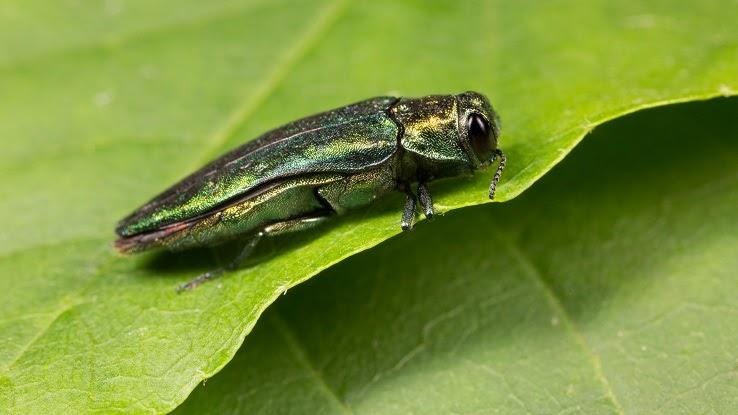
The emerald ash borer, commonly referred to just by the initials EAB, is an invasive beetle species. The green-colored insect is native to parts of Asia, but, over the years, has become an incredibly harmful invasive species throughout North America, threatening the survival of North American ash trees.
Without any natural predators to regulate the beetle, experts are now trying to find other methods of eradicating it to save the remaining ash trees — but attempts are proving both costly and ineffective. So, how can we stop the emerald ash borer from destroying our forests?
What Is an Emerald Ash Borer?
The emerald ash borer was first recorded by Armand David, a naturalist who visited China in the 1870s. While David wrote about the beetle in a French entomology publication, a later entomologist, Jan Obenberger, actually gave the beetle its scientific name.
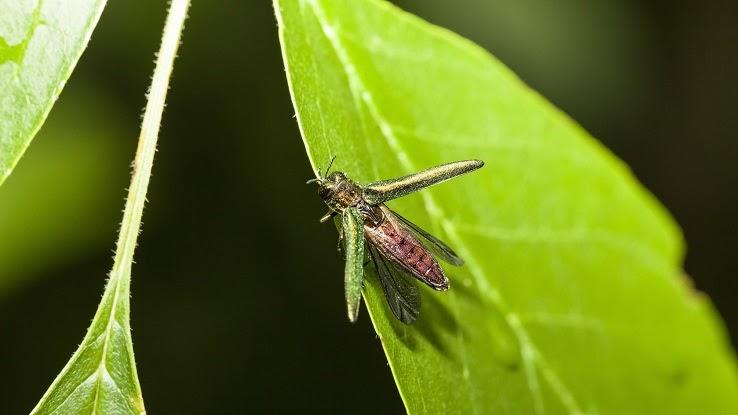
As their name suggests, EABs are a dazzling shade of green, similar to an emerald gemstone. And while the EAB is native to China, Japan, Russia, and North and South Korea, there’s a growing population in the eastern and midwestern regions of the United States. Additionally, there are smaller pockets of EABs scattered throughout Canada.
Scientists are not sure exactly when or how the EAB made it to North America. There is a hypothesis that suggests the bugs may have traveled to the Americas on wooden shipping crates made of ash. The first recorded sightings of the beetle in North American happened in Michigan in 2002. Since then, the EAB population has rapidly spread to a total of 35 American states.
What Is an Invasive Species?
An invasive species is any living organism that causes harm by living in a non-native environment. Sometimes, they are referred to as an introduced species — a much gentler name, all things considered. More often than not, invasive species are introduced to a new ecosystem through negligence or by accident. In addition to insects and other animals of all sorts, invasive species can also be plants, bacteria and fungi.
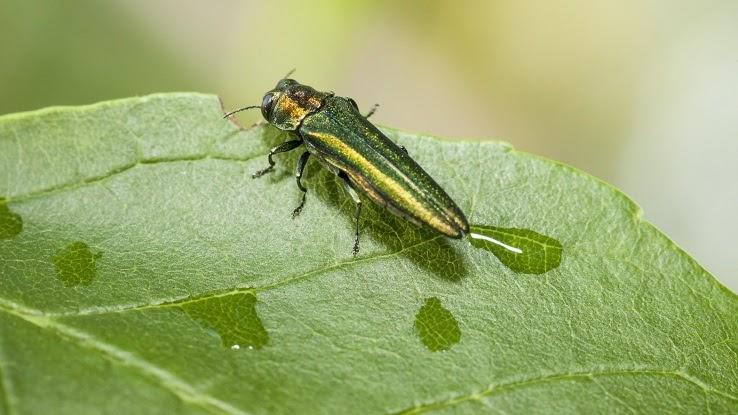
The surprising part? Organisms that are harmless in one ecosystem can be extremely devastating in another, namely because the invading organism doesn’t have any natural predators in the new ecosystem. In other cases, members of an ecosystem aren’t equipped to protect themselves from an invasive species. For example, while the EAB population does bore into ash trees in its native ecosystems, it’s kept in check. Here, there aren’t natural obstacles, which means it will move from tree to tree, wreaking havoc.
How Does the Emerald Ash Borer Decimate Ash Trees?
The EAB bores into the vascular system of ash trees. Additionally, they eat ash leaves and lay eggs on the bark. When those eggs hatch, the new generation of EAB larvae bores into the tree to feed on its deepest tissues.
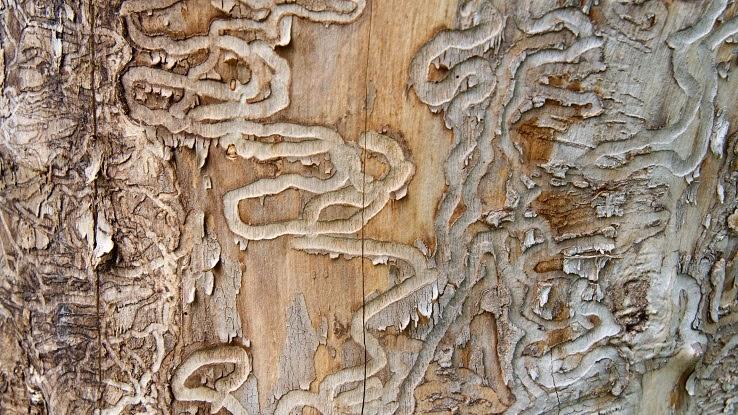
As you may know, the water and nutrients that keep trees alive come from the ground, and, as a result, trees have specialized tissues that pull said water and nutrients up from the ground and distribute those essentials throughout its limbs and leaves. This all-important tissue is exactly what EAB larvae eat.
The complex inner workings of a tree can only withstand so much damage before the tree begins to decay due to a lack of nutrients. Think of it this way: the ongoing boring can be as detrimental to a tree as it would be to disrupt the vascular system that brings nutrient-rich blood to the heart and brain of a human.
Why Are Emerald Ash Borers So Damaging to North American Ecosystems?
EABs only eat blue, black, green, and white ash; blue ash is the least desirable, while white ash is the most desirable. There are far more blue ash trees in Asia and far more white ash in the Americas, which makes it such a desirable feasting ground. Additionally, blue ash has more tannic acid than white ash, and, since EABs aren’t too fond of tannic acid, they’ll just attack a few trees in a native ecosystem. In North America, however, they’ll attack a whole forest of white ash since there isn’t any tannic acid to curb their appetites.
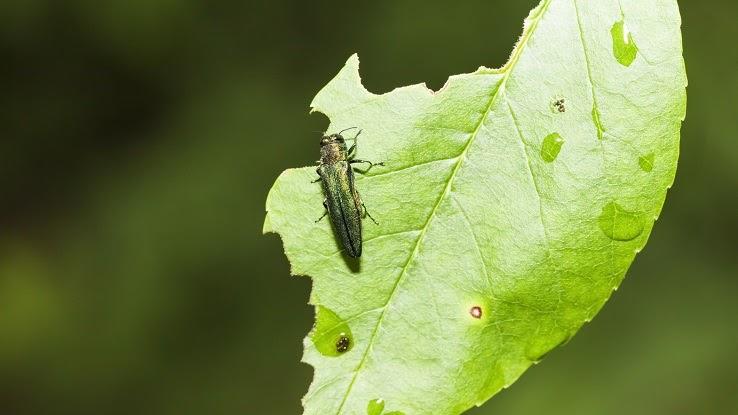
To make matters worse, the beetle doesn’t have any natural predators in North America. Sure, woodpeckers eat them, but a beetle is not the woodpecker’s first instinctual choice of food. Thus, with plenty of desirable trees and few predators, the EAB population has been left to thrive, relatively unchecked.
While a single brood of larvae boring a few holes into an ash tree will cause damage, said boring won’t actually kill the tree. However, in the U.S., there’s rarely just one brood. Since the EAB population isn’t controlled by predation, they’ll keep boring holes and spawning more larvae over and over again in the same group of trees. Within just a few years, this damaging process can start to thin out a whole forest.
What Can Be Done to Stop Emerald Ash Borers?
The EAB population has already exploded to a level that makes total eradication impossible. Moreover, the EAB proves to be quite the insidious pest because, by the time there are visible signs of an infestation on the outside of a tree, permanent damage has already been done to the inside of the tree. That said, the beetle really could endanger certain ash populations.

Efforts to quarantine trees from states with EAB infestations have failed. However, insecticides have been proven to be one of the most effective methods for curbing the EAB population. Even so, there are only four types of insecticide on the market that actually kill EABs — at least in terms of what homeowners can purchase. Professionals have a decidedly wider variety of insecticide options.
Still, the insecticides used to treat EAB infestations are expensive, so fixing the issue has become costly for several municipalities. Some communities have found success by marking ash trees so that community members can look out for the visible signs of an infestation, such as the leaves of the tree appearing to be thin or sparse. Once an infested tree has been discovered, insecticides are applied in these early stages to mitigate the spread and damage.
The bottom line? Awareness is the key to mitigating the spread of the invasive emerald ash borer. Plus, catching an infestation early can help cash-strapped communities bear the cost of EAB treatment. The first step in raising awareness is learning about emerald ash borers. Then you can encourage others in your community to recognize the signs — and imminent dangers — associated with EAB infestation too.





